Enterprise Information Architecture on Government Service Report
VerifiedAdded on 2023/01/19
|12
|2297
|52
Report
AI Summary
This report explores the application of Enterprise Information Architecture (EIA) in developing an e-government system for the United Nations, highlighting the benefits over traditional government services. It discusses the implementation of Intelligent Enterprise Design to enhance government service effectiveness through citizen-centric approaches, common infrastructure, interoperability, and business collaboration. The report elaborates on the decision-making process, unstructured data processing, and the Enterprise Information Architecture Reference Architecture (EIA RA). It concludes by identifying drawbacks related to information security, business collaboration, and technical faults, recommending mitigation strategies to improve the system's efficiency and security. The document emphasizes the potential of EIA to revolutionize government services while acknowledging the need for addressing its limitations for optimal performance. Desklib offers a wealth of similar solved assignments and study resources for students.
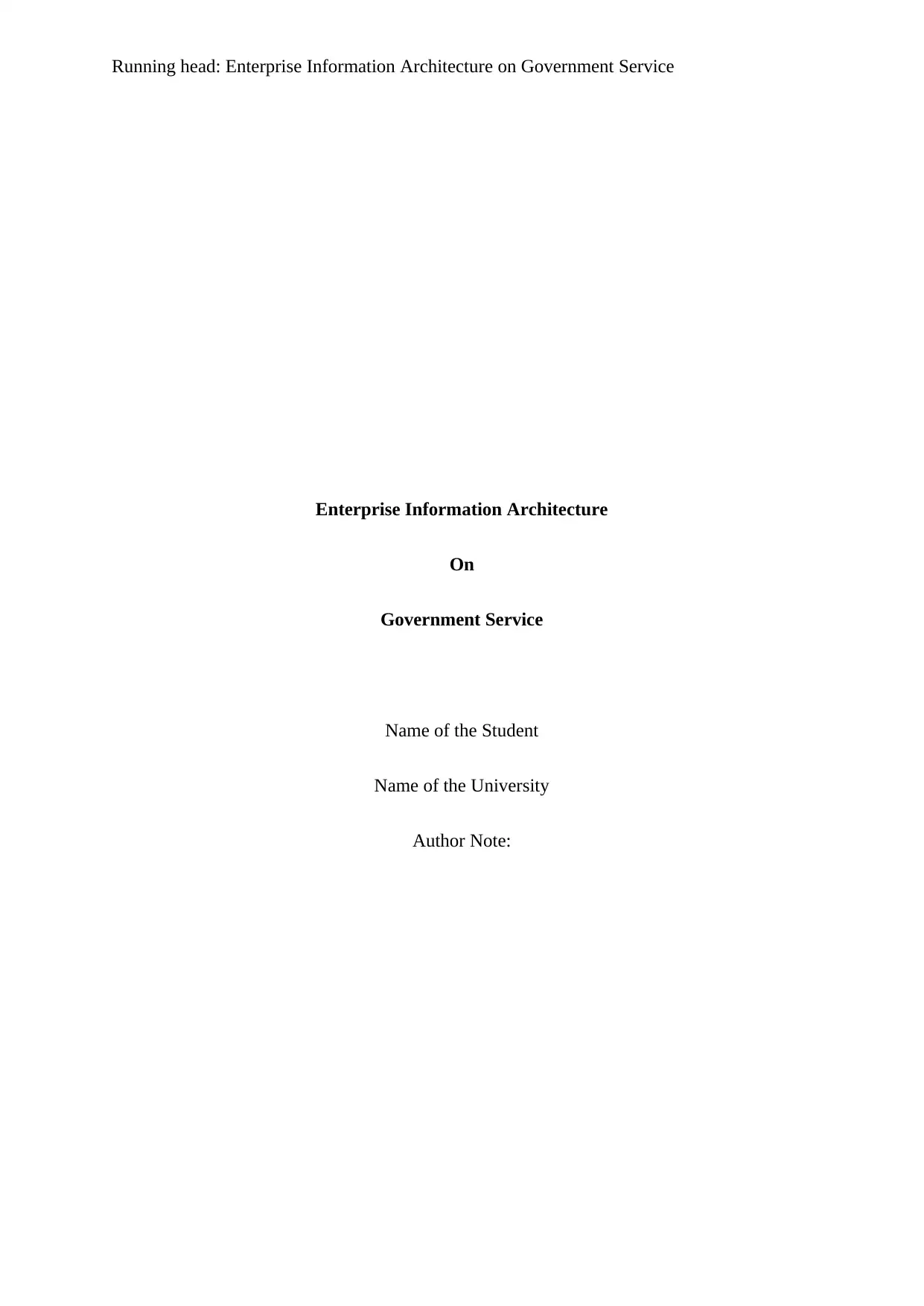
Running head: Enterprise Information Architecture on Government Service
Enterprise Information Architecture
On
Government Service
Name of the Student
Name of the University
Author Note:
Enterprise Information Architecture
On
Government Service
Name of the Student
Name of the University
Author Note:
Paraphrase This Document
Need a fresh take? Get an instant paraphrase of this document with our AI Paraphraser
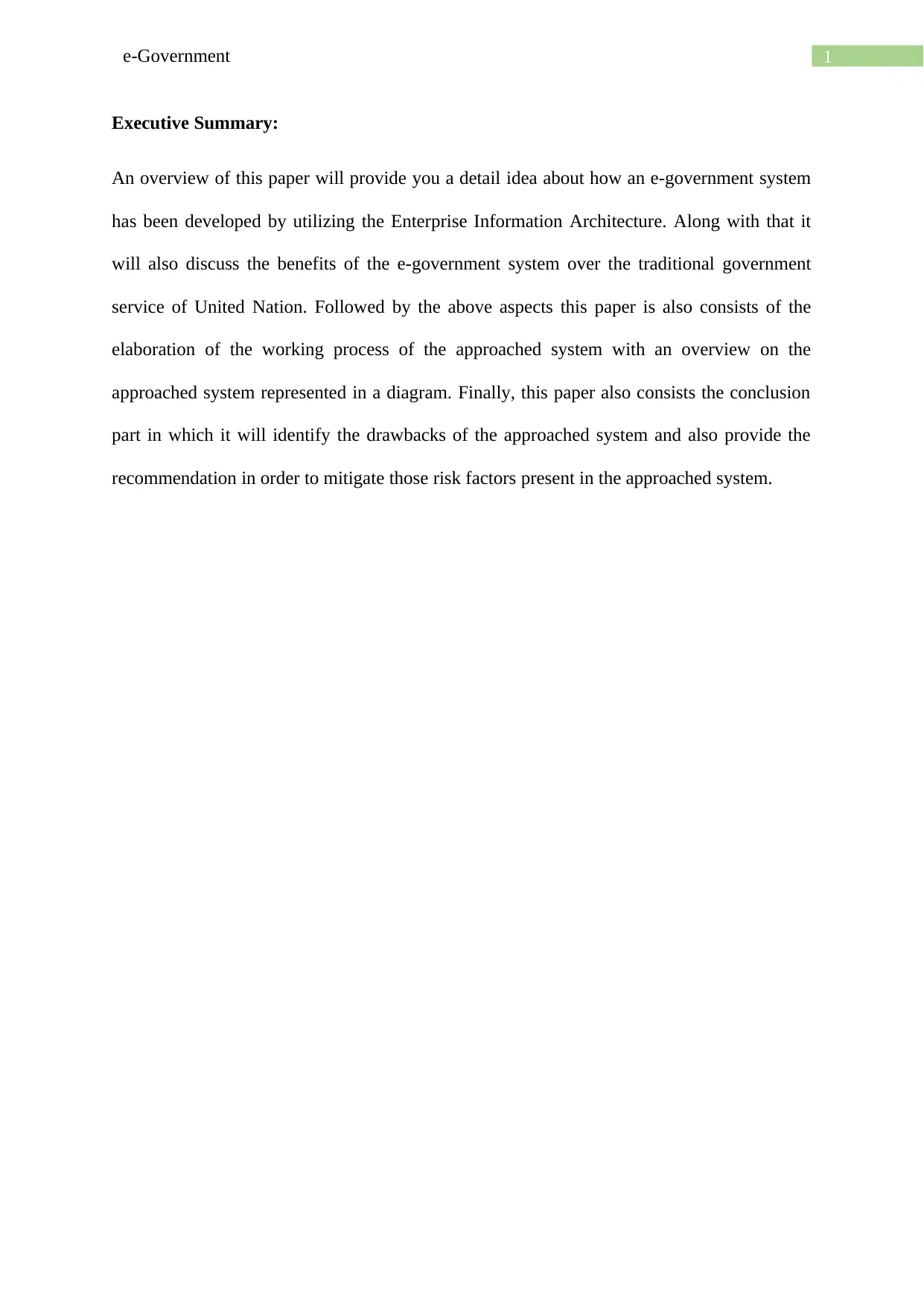
1e-Government
Executive Summary:
An overview of this paper will provide you a detail idea about how an e-government system
has been developed by utilizing the Enterprise Information Architecture. Along with that it
will also discuss the benefits of the e-government system over the traditional government
service of United Nation. Followed by the above aspects this paper is also consists of the
elaboration of the working process of the approached system with an overview on the
approached system represented in a diagram. Finally, this paper also consists the conclusion
part in which it will identify the drawbacks of the approached system and also provide the
recommendation in order to mitigate those risk factors present in the approached system.
Executive Summary:
An overview of this paper will provide you a detail idea about how an e-government system
has been developed by utilizing the Enterprise Information Architecture. Along with that it
will also discuss the benefits of the e-government system over the traditional government
service of United Nation. Followed by the above aspects this paper is also consists of the
elaboration of the working process of the approached system with an overview on the
approached system represented in a diagram. Finally, this paper also consists the conclusion
part in which it will identify the drawbacks of the approached system and also provide the
recommendation in order to mitigate those risk factors present in the approached system.
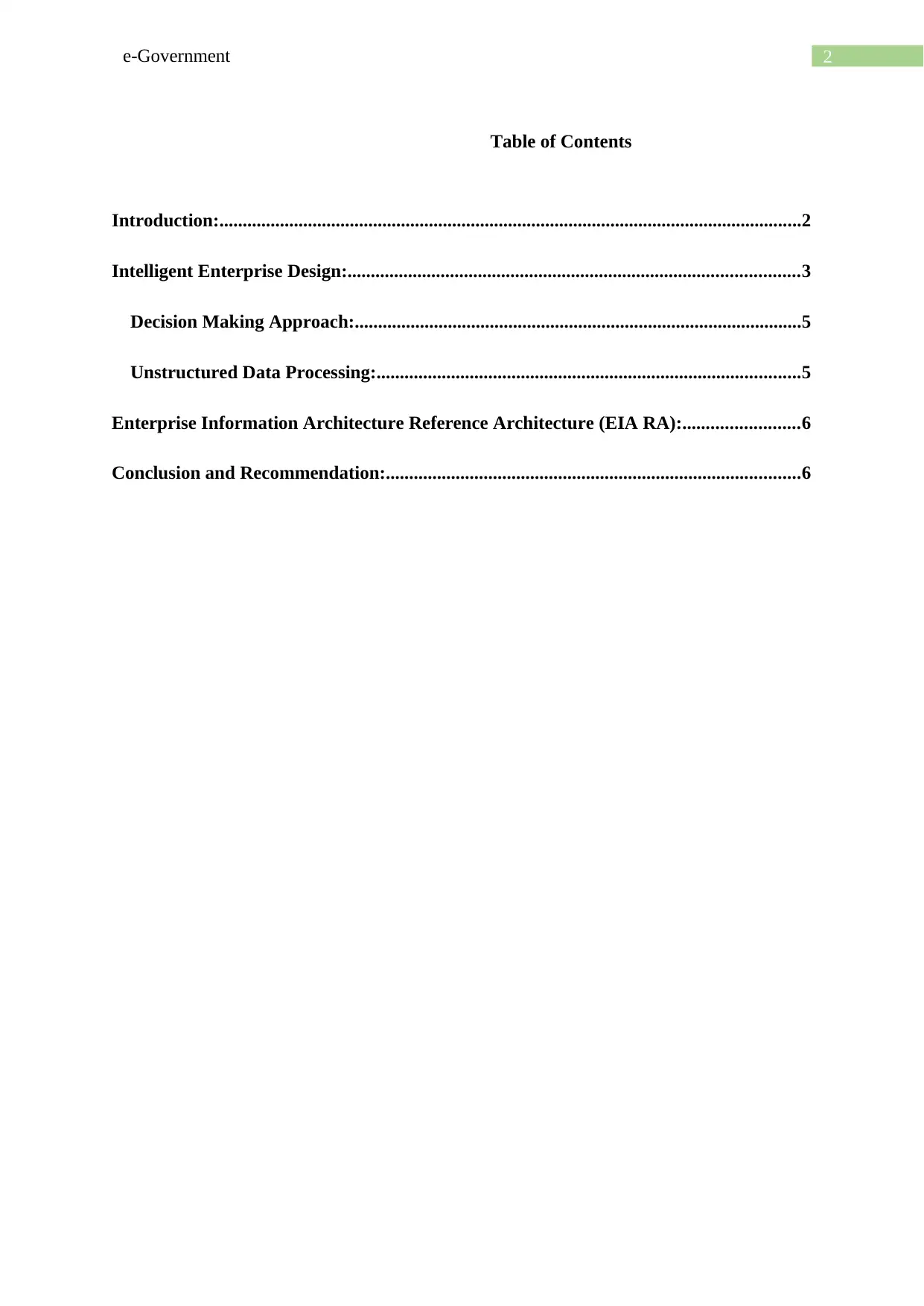
2e-Government
Table of Contents
Introduction:.............................................................................................................................2
Intelligent Enterprise Design:.................................................................................................3
Decision Making Approach:................................................................................................5
Unstructured Data Processing:...........................................................................................5
Enterprise Information Architecture Reference Architecture (EIA RA):.........................6
Conclusion and Recommendation:.........................................................................................6
Table of Contents
Introduction:.............................................................................................................................2
Intelligent Enterprise Design:.................................................................................................3
Decision Making Approach:................................................................................................5
Unstructured Data Processing:...........................................................................................5
Enterprise Information Architecture Reference Architecture (EIA RA):.........................6
Conclusion and Recommendation:.........................................................................................6
⊘ This is a preview!⊘
Do you want full access?
Subscribe today to unlock all pages.

Trusted by 1+ million students worldwide
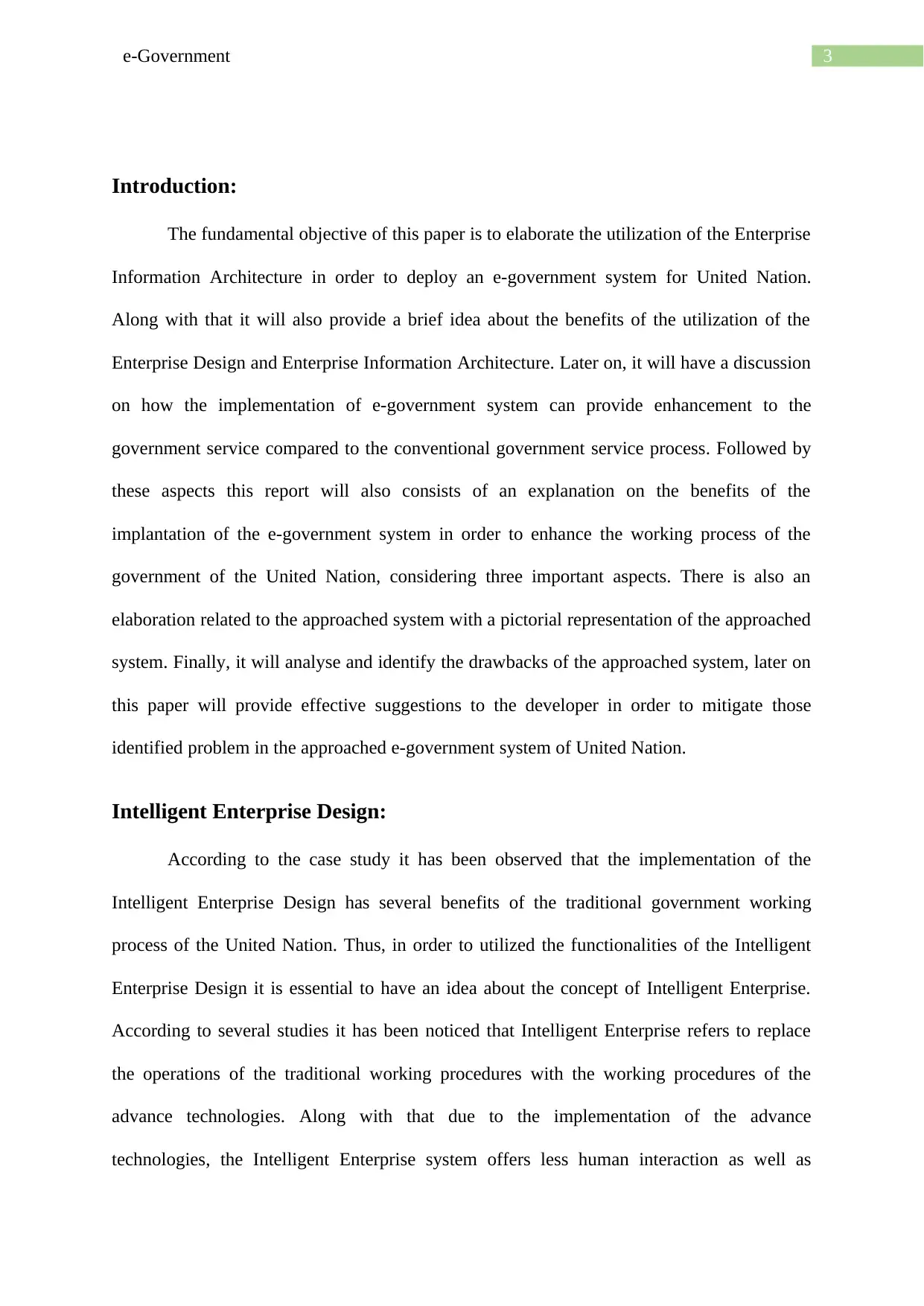
3e-Government
Introduction:
The fundamental objective of this paper is to elaborate the utilization of the Enterprise
Information Architecture in order to deploy an e-government system for United Nation.
Along with that it will also provide a brief idea about the benefits of the utilization of the
Enterprise Design and Enterprise Information Architecture. Later on, it will have a discussion
on how the implementation of e-government system can provide enhancement to the
government service compared to the conventional government service process. Followed by
these aspects this report will also consists of an explanation on the benefits of the
implantation of the e-government system in order to enhance the working process of the
government of the United Nation, considering three important aspects. There is also an
elaboration related to the approached system with a pictorial representation of the approached
system. Finally, it will analyse and identify the drawbacks of the approached system, later on
this paper will provide effective suggestions to the developer in order to mitigate those
identified problem in the approached e-government system of United Nation.
Intelligent Enterprise Design:
According to the case study it has been observed that the implementation of the
Intelligent Enterprise Design has several benefits of the traditional government working
process of the United Nation. Thus, in order to utilized the functionalities of the Intelligent
Enterprise Design it is essential to have an idea about the concept of Intelligent Enterprise.
According to several studies it has been noticed that Intelligent Enterprise refers to replace
the operations of the traditional working procedures with the working procedures of the
advance technologies. Along with that due to the implementation of the advance
technologies, the Intelligent Enterprise system offers less human interaction as well as
Introduction:
The fundamental objective of this paper is to elaborate the utilization of the Enterprise
Information Architecture in order to deploy an e-government system for United Nation.
Along with that it will also provide a brief idea about the benefits of the utilization of the
Enterprise Design and Enterprise Information Architecture. Later on, it will have a discussion
on how the implementation of e-government system can provide enhancement to the
government service compared to the conventional government service process. Followed by
these aspects this report will also consists of an explanation on the benefits of the
implantation of the e-government system in order to enhance the working process of the
government of the United Nation, considering three important aspects. There is also an
elaboration related to the approached system with a pictorial representation of the approached
system. Finally, it will analyse and identify the drawbacks of the approached system, later on
this paper will provide effective suggestions to the developer in order to mitigate those
identified problem in the approached e-government system of United Nation.
Intelligent Enterprise Design:
According to the case study it has been observed that the implementation of the
Intelligent Enterprise Design has several benefits of the traditional government working
process of the United Nation. Thus, in order to utilized the functionalities of the Intelligent
Enterprise Design it is essential to have an idea about the concept of Intelligent Enterprise.
According to several studies it has been noticed that Intelligent Enterprise refers to replace
the operations of the traditional working procedures with the working procedures of the
advance technologies. Along with that due to the implementation of the advance
technologies, the Intelligent Enterprise system offers less human interaction as well as
Paraphrase This Document
Need a fresh take? Get an instant paraphrase of this document with our AI Paraphraser
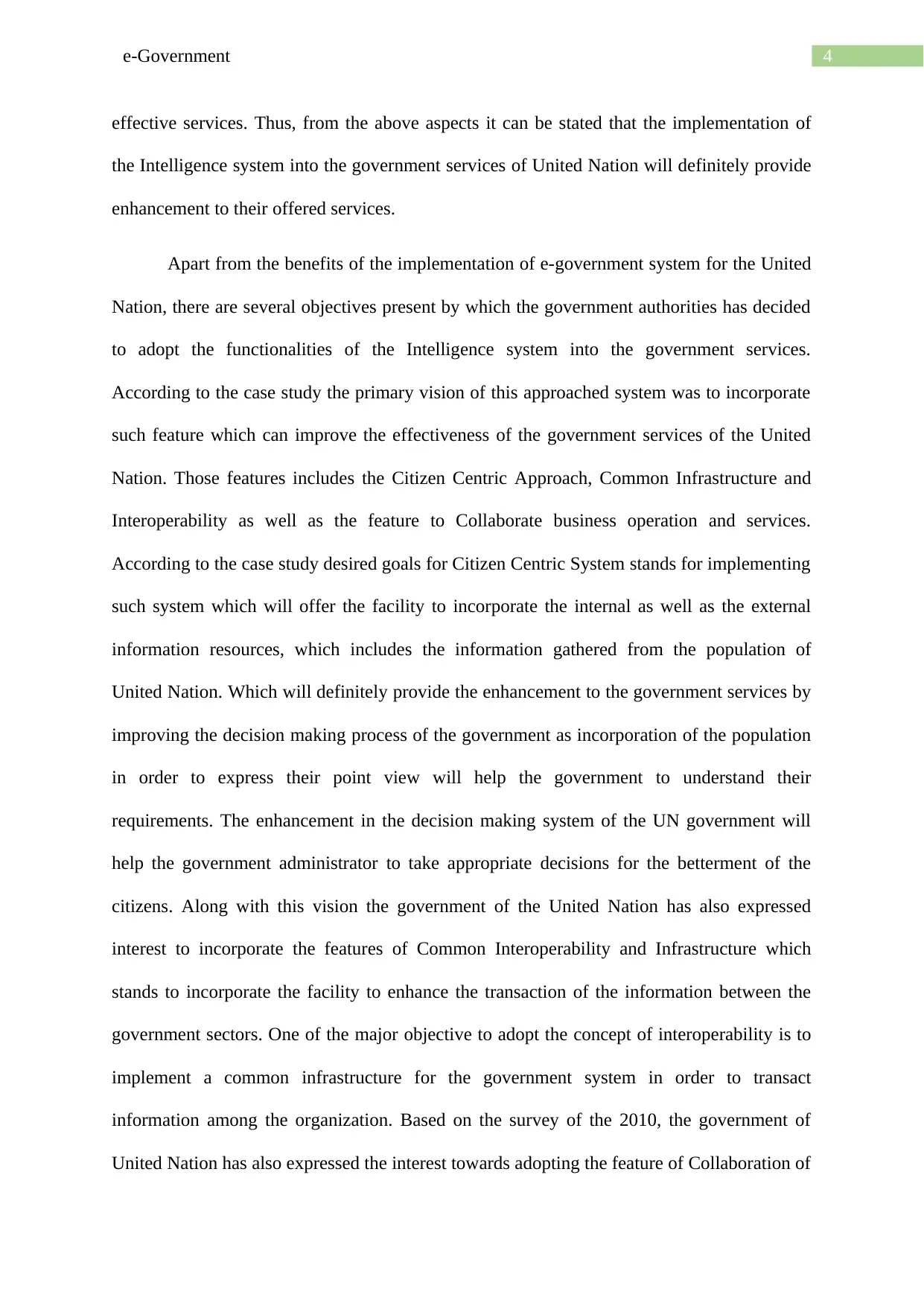
4e-Government
effective services. Thus, from the above aspects it can be stated that the implementation of
the Intelligence system into the government services of United Nation will definitely provide
enhancement to their offered services.
Apart from the benefits of the implementation of e-government system for the United
Nation, there are several objectives present by which the government authorities has decided
to adopt the functionalities of the Intelligence system into the government services.
According to the case study the primary vision of this approached system was to incorporate
such feature which can improve the effectiveness of the government services of the United
Nation. Those features includes the Citizen Centric Approach, Common Infrastructure and
Interoperability as well as the feature to Collaborate business operation and services.
According to the case study desired goals for Citizen Centric System stands for implementing
such system which will offer the facility to incorporate the internal as well as the external
information resources, which includes the information gathered from the population of
United Nation. Which will definitely provide the enhancement to the government services by
improving the decision making process of the government as incorporation of the population
in order to express their point view will help the government to understand their
requirements. The enhancement in the decision making system of the UN government will
help the government administrator to take appropriate decisions for the betterment of the
citizens. Along with this vision the government of the United Nation has also expressed
interest to incorporate the features of Common Interoperability and Infrastructure which
stands to incorporate the facility to enhance the transaction of the information between the
government sectors. One of the major objective to adopt the concept of interoperability is to
implement a common infrastructure for the government system in order to transact
information among the organization. Based on the survey of the 2010, the government of
United Nation has also expressed the interest towards adopting the feature of Collaboration of
effective services. Thus, from the above aspects it can be stated that the implementation of
the Intelligence system into the government services of United Nation will definitely provide
enhancement to their offered services.
Apart from the benefits of the implementation of e-government system for the United
Nation, there are several objectives present by which the government authorities has decided
to adopt the functionalities of the Intelligence system into the government services.
According to the case study the primary vision of this approached system was to incorporate
such feature which can improve the effectiveness of the government services of the United
Nation. Those features includes the Citizen Centric Approach, Common Infrastructure and
Interoperability as well as the feature to Collaborate business operation and services.
According to the case study desired goals for Citizen Centric System stands for implementing
such system which will offer the facility to incorporate the internal as well as the external
information resources, which includes the information gathered from the population of
United Nation. Which will definitely provide the enhancement to the government services by
improving the decision making process of the government as incorporation of the population
in order to express their point view will help the government to understand their
requirements. The enhancement in the decision making system of the UN government will
help the government administrator to take appropriate decisions for the betterment of the
citizens. Along with this vision the government of the United Nation has also expressed
interest to incorporate the features of Common Interoperability and Infrastructure which
stands to incorporate the facility to enhance the transaction of the information between the
government sectors. One of the major objective to adopt the concept of interoperability is to
implement a common infrastructure for the government system in order to transact
information among the organization. Based on the survey of the 2010, the government of
United Nation has also expressed the interest towards adopting the feature of Collaboration of
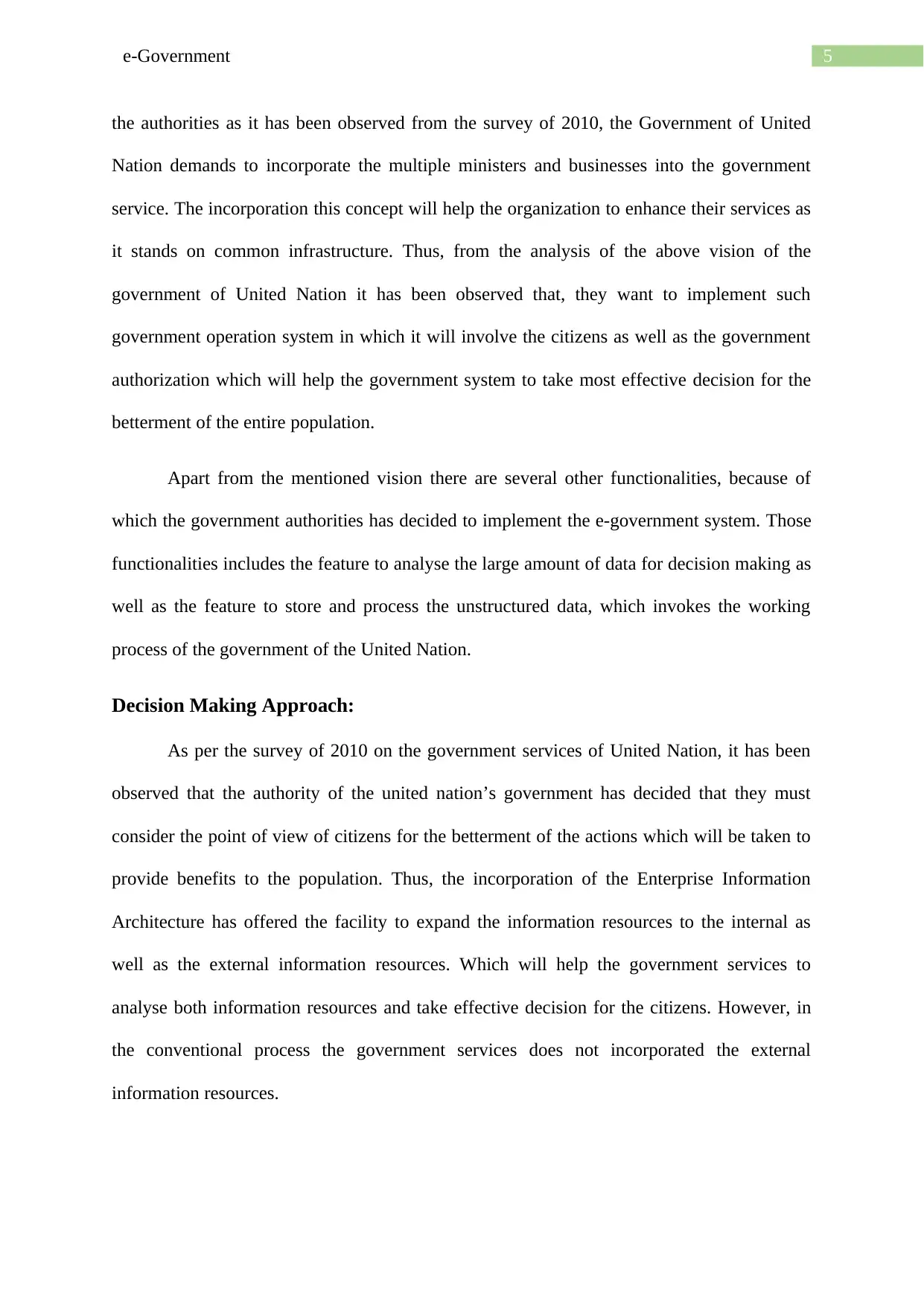
5e-Government
the authorities as it has been observed from the survey of 2010, the Government of United
Nation demands to incorporate the multiple ministers and businesses into the government
service. The incorporation this concept will help the organization to enhance their services as
it stands on common infrastructure. Thus, from the analysis of the above vision of the
government of United Nation it has been observed that, they want to implement such
government operation system in which it will involve the citizens as well as the government
authorization which will help the government system to take most effective decision for the
betterment of the entire population.
Apart from the mentioned vision there are several other functionalities, because of
which the government authorities has decided to implement the e-government system. Those
functionalities includes the feature to analyse the large amount of data for decision making as
well as the feature to store and process the unstructured data, which invokes the working
process of the government of the United Nation.
Decision Making Approach:
As per the survey of 2010 on the government services of United Nation, it has been
observed that the authority of the united nation’s government has decided that they must
consider the point of view of citizens for the betterment of the actions which will be taken to
provide benefits to the population. Thus, the incorporation of the Enterprise Information
Architecture has offered the facility to expand the information resources to the internal as
well as the external information resources. Which will help the government services to
analyse both information resources and take effective decision for the citizens. However, in
the conventional process the government services does not incorporated the external
information resources.
the authorities as it has been observed from the survey of 2010, the Government of United
Nation demands to incorporate the multiple ministers and businesses into the government
service. The incorporation this concept will help the organization to enhance their services as
it stands on common infrastructure. Thus, from the analysis of the above vision of the
government of United Nation it has been observed that, they want to implement such
government operation system in which it will involve the citizens as well as the government
authorization which will help the government system to take most effective decision for the
betterment of the entire population.
Apart from the mentioned vision there are several other functionalities, because of
which the government authorities has decided to implement the e-government system. Those
functionalities includes the feature to analyse the large amount of data for decision making as
well as the feature to store and process the unstructured data, which invokes the working
process of the government of the United Nation.
Decision Making Approach:
As per the survey of 2010 on the government services of United Nation, it has been
observed that the authority of the united nation’s government has decided that they must
consider the point of view of citizens for the betterment of the actions which will be taken to
provide benefits to the population. Thus, the incorporation of the Enterprise Information
Architecture has offered the facility to expand the information resources to the internal as
well as the external information resources. Which will help the government services to
analyse both information resources and take effective decision for the citizens. However, in
the conventional process the government services does not incorporated the external
information resources.
⊘ This is a preview!⊘
Do you want full access?
Subscribe today to unlock all pages.

Trusted by 1+ million students worldwide
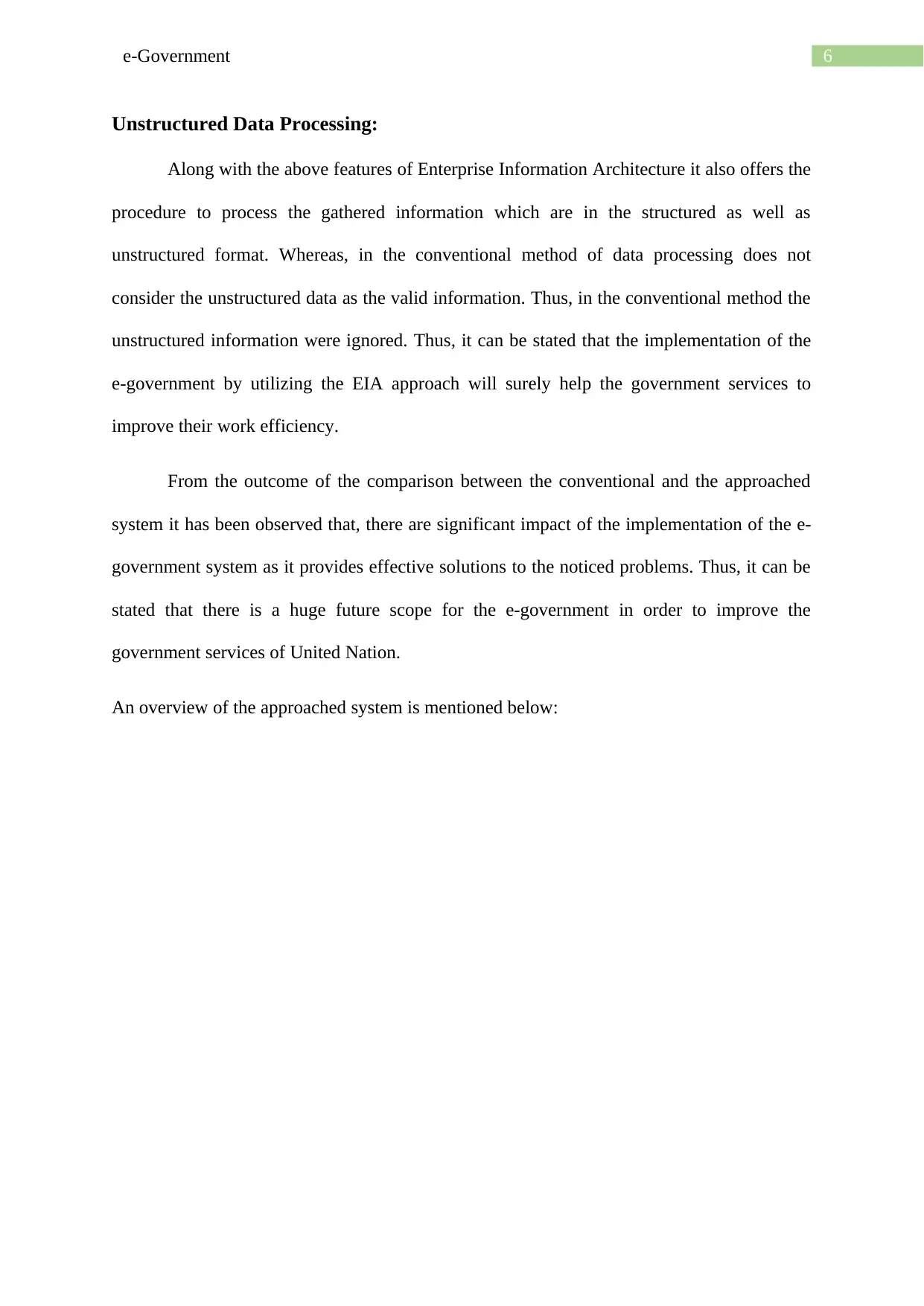
6e-Government
Unstructured Data Processing:
Along with the above features of Enterprise Information Architecture it also offers the
procedure to process the gathered information which are in the structured as well as
unstructured format. Whereas, in the conventional method of data processing does not
consider the unstructured data as the valid information. Thus, in the conventional method the
unstructured information were ignored. Thus, it can be stated that the implementation of the
e-government by utilizing the EIA approach will surely help the government services to
improve their work efficiency.
From the outcome of the comparison between the conventional and the approached
system it has been observed that, there are significant impact of the implementation of the e-
government system as it provides effective solutions to the noticed problems. Thus, it can be
stated that there is a huge future scope for the e-government in order to improve the
government services of United Nation.
An overview of the approached system is mentioned below:
Unstructured Data Processing:
Along with the above features of Enterprise Information Architecture it also offers the
procedure to process the gathered information which are in the structured as well as
unstructured format. Whereas, in the conventional method of data processing does not
consider the unstructured data as the valid information. Thus, in the conventional method the
unstructured information were ignored. Thus, it can be stated that the implementation of the
e-government by utilizing the EIA approach will surely help the government services to
improve their work efficiency.
From the outcome of the comparison between the conventional and the approached
system it has been observed that, there are significant impact of the implementation of the e-
government system as it provides effective solutions to the noticed problems. Thus, it can be
stated that there is a huge future scope for the e-government in order to improve the
government services of United Nation.
An overview of the approached system is mentioned below:
Paraphrase This Document
Need a fresh take? Get an instant paraphrase of this document with our AI Paraphraser
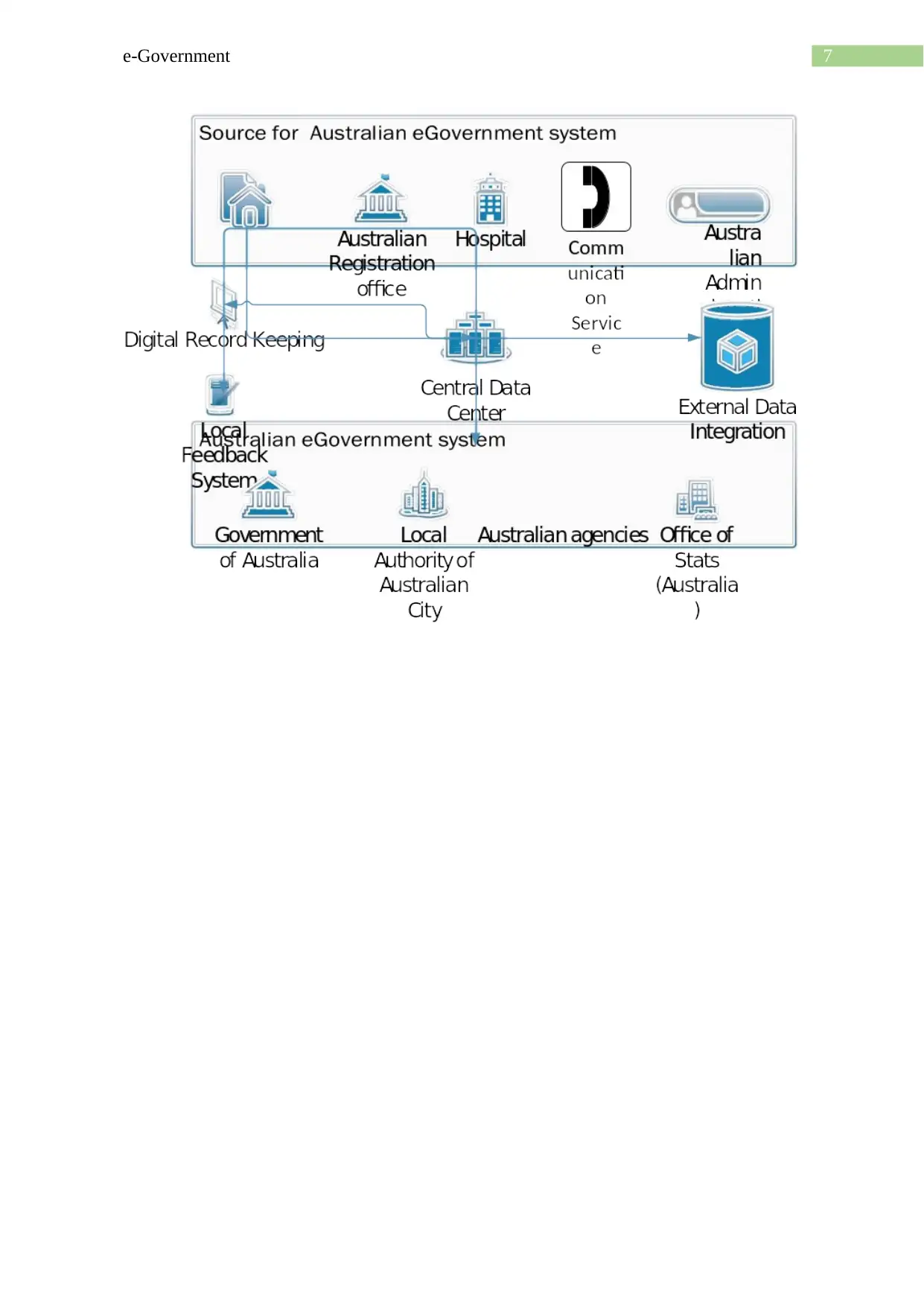
7e-Government
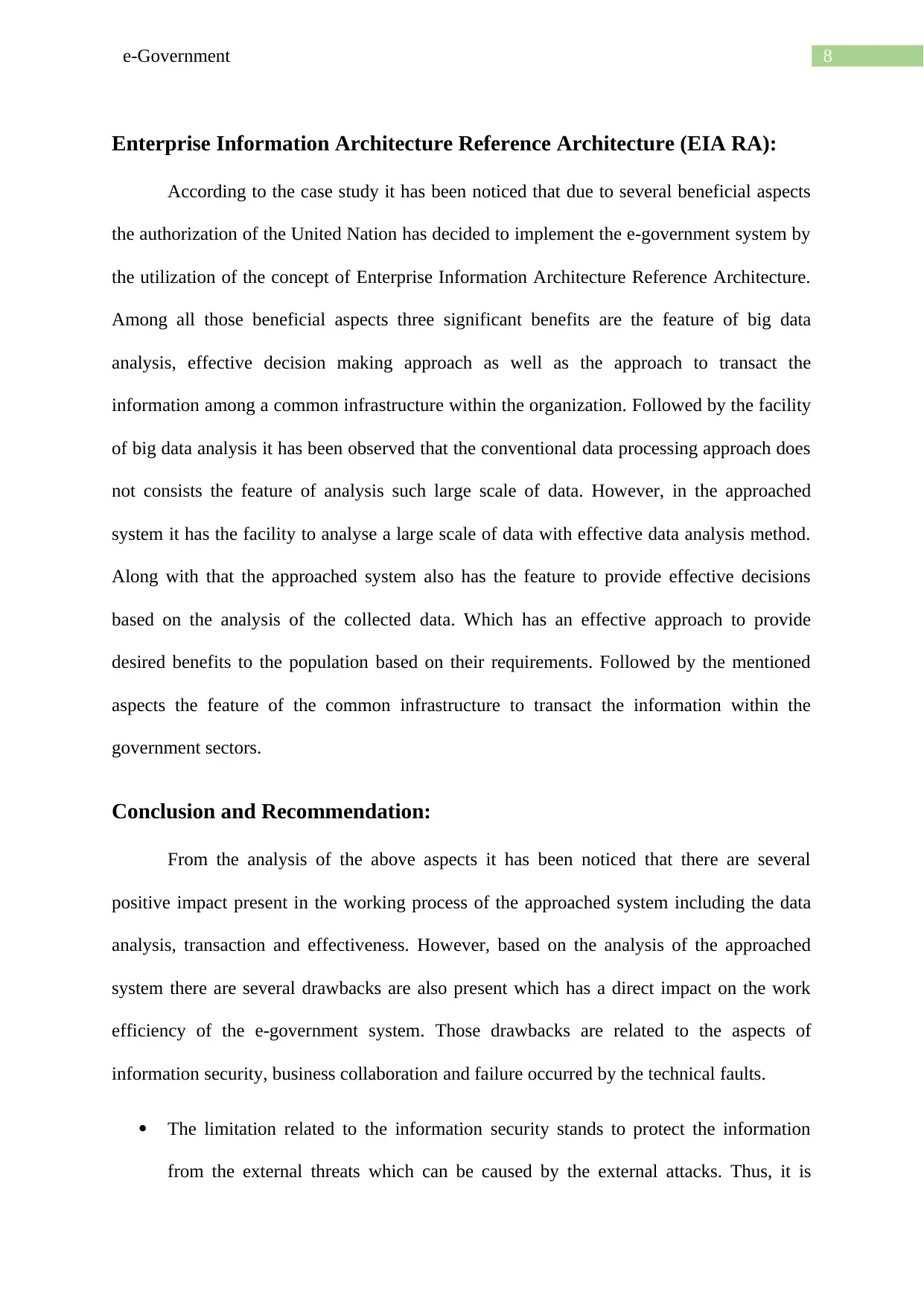
8e-Government
Enterprise Information Architecture Reference Architecture (EIA RA):
According to the case study it has been noticed that due to several beneficial aspects
the authorization of the United Nation has decided to implement the e-government system by
the utilization of the concept of Enterprise Information Architecture Reference Architecture.
Among all those beneficial aspects three significant benefits are the feature of big data
analysis, effective decision making approach as well as the approach to transact the
information among a common infrastructure within the organization. Followed by the facility
of big data analysis it has been observed that the conventional data processing approach does
not consists the feature of analysis such large scale of data. However, in the approached
system it has the facility to analyse a large scale of data with effective data analysis method.
Along with that the approached system also has the feature to provide effective decisions
based on the analysis of the collected data. Which has an effective approach to provide
desired benefits to the population based on their requirements. Followed by the mentioned
aspects the feature of the common infrastructure to transact the information within the
government sectors.
Conclusion and Recommendation:
From the analysis of the above aspects it has been noticed that there are several
positive impact present in the working process of the approached system including the data
analysis, transaction and effectiveness. However, based on the analysis of the approached
system there are several drawbacks are also present which has a direct impact on the work
efficiency of the e-government system. Those drawbacks are related to the aspects of
information security, business collaboration and failure occurred by the technical faults.
The limitation related to the information security stands to protect the information
from the external threats which can be caused by the external attacks. Thus, it is
Enterprise Information Architecture Reference Architecture (EIA RA):
According to the case study it has been noticed that due to several beneficial aspects
the authorization of the United Nation has decided to implement the e-government system by
the utilization of the concept of Enterprise Information Architecture Reference Architecture.
Among all those beneficial aspects three significant benefits are the feature of big data
analysis, effective decision making approach as well as the approach to transact the
information among a common infrastructure within the organization. Followed by the facility
of big data analysis it has been observed that the conventional data processing approach does
not consists the feature of analysis such large scale of data. However, in the approached
system it has the facility to analyse a large scale of data with effective data analysis method.
Along with that the approached system also has the feature to provide effective decisions
based on the analysis of the collected data. Which has an effective approach to provide
desired benefits to the population based on their requirements. Followed by the mentioned
aspects the feature of the common infrastructure to transact the information within the
government sectors.
Conclusion and Recommendation:
From the analysis of the above aspects it has been noticed that there are several
positive impact present in the working process of the approached system including the data
analysis, transaction and effectiveness. However, based on the analysis of the approached
system there are several drawbacks are also present which has a direct impact on the work
efficiency of the e-government system. Those drawbacks are related to the aspects of
information security, business collaboration and failure occurred by the technical faults.
The limitation related to the information security stands to protect the information
from the external threats which can be caused by the external attacks. Thus, it is
⊘ This is a preview!⊘
Do you want full access?
Subscribe today to unlock all pages.

Trusted by 1+ million students worldwide
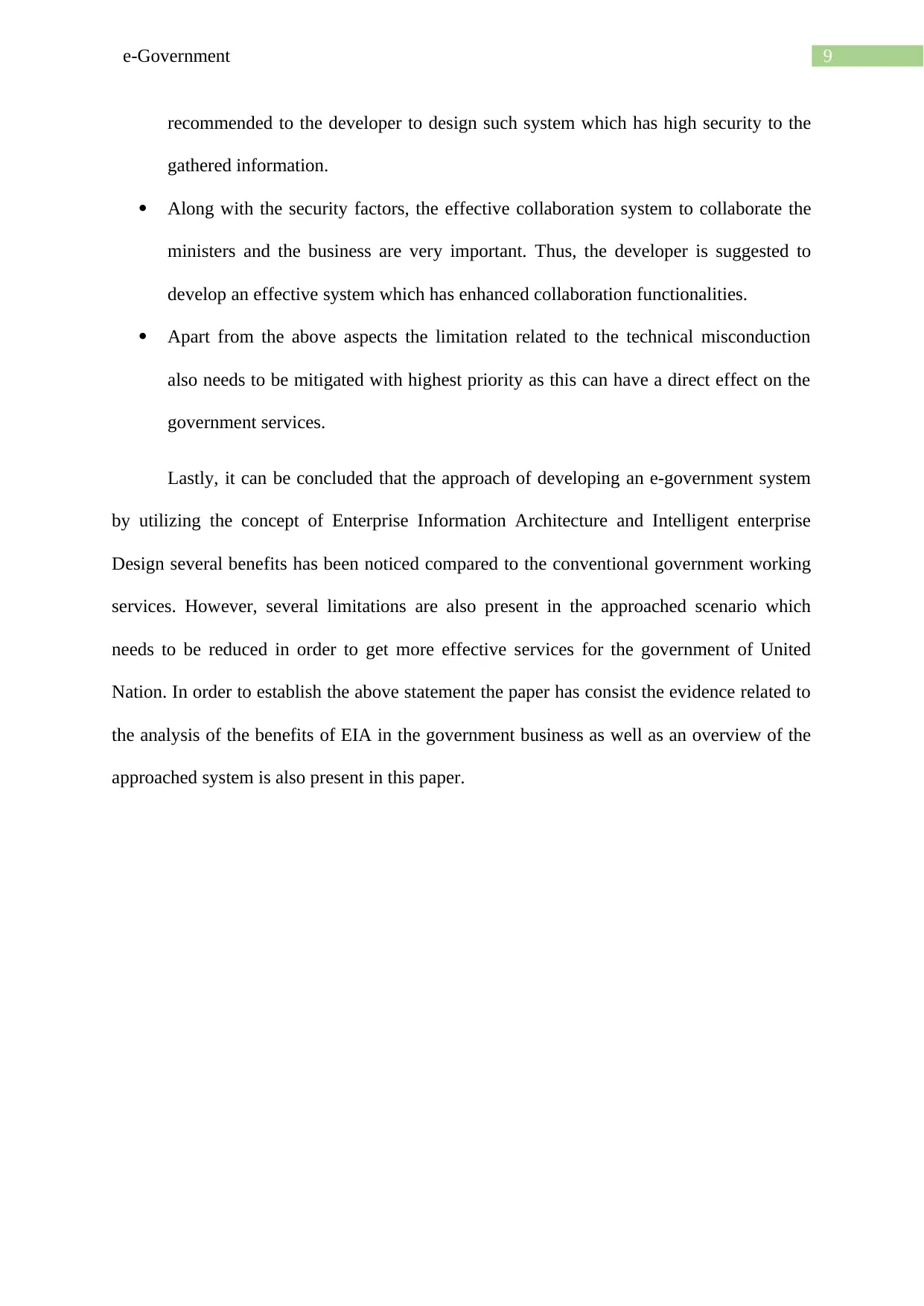
9e-Government
recommended to the developer to design such system which has high security to the
gathered information.
Along with the security factors, the effective collaboration system to collaborate the
ministers and the business are very important. Thus, the developer is suggested to
develop an effective system which has enhanced collaboration functionalities.
Apart from the above aspects the limitation related to the technical misconduction
also needs to be mitigated with highest priority as this can have a direct effect on the
government services.
Lastly, it can be concluded that the approach of developing an e-government system
by utilizing the concept of Enterprise Information Architecture and Intelligent enterprise
Design several benefits has been noticed compared to the conventional government working
services. However, several limitations are also present in the approached scenario which
needs to be reduced in order to get more effective services for the government of United
Nation. In order to establish the above statement the paper has consist the evidence related to
the analysis of the benefits of EIA in the government business as well as an overview of the
approached system is also present in this paper.
recommended to the developer to design such system which has high security to the
gathered information.
Along with the security factors, the effective collaboration system to collaborate the
ministers and the business are very important. Thus, the developer is suggested to
develop an effective system which has enhanced collaboration functionalities.
Apart from the above aspects the limitation related to the technical misconduction
also needs to be mitigated with highest priority as this can have a direct effect on the
government services.
Lastly, it can be concluded that the approach of developing an e-government system
by utilizing the concept of Enterprise Information Architecture and Intelligent enterprise
Design several benefits has been noticed compared to the conventional government working
services. However, several limitations are also present in the approached scenario which
needs to be reduced in order to get more effective services for the government of United
Nation. In order to establish the above statement the paper has consist the evidence related to
the analysis of the benefits of EIA in the government business as well as an overview of the
approached system is also present in this paper.
Paraphrase This Document
Need a fresh take? Get an instant paraphrase of this document with our AI Paraphraser
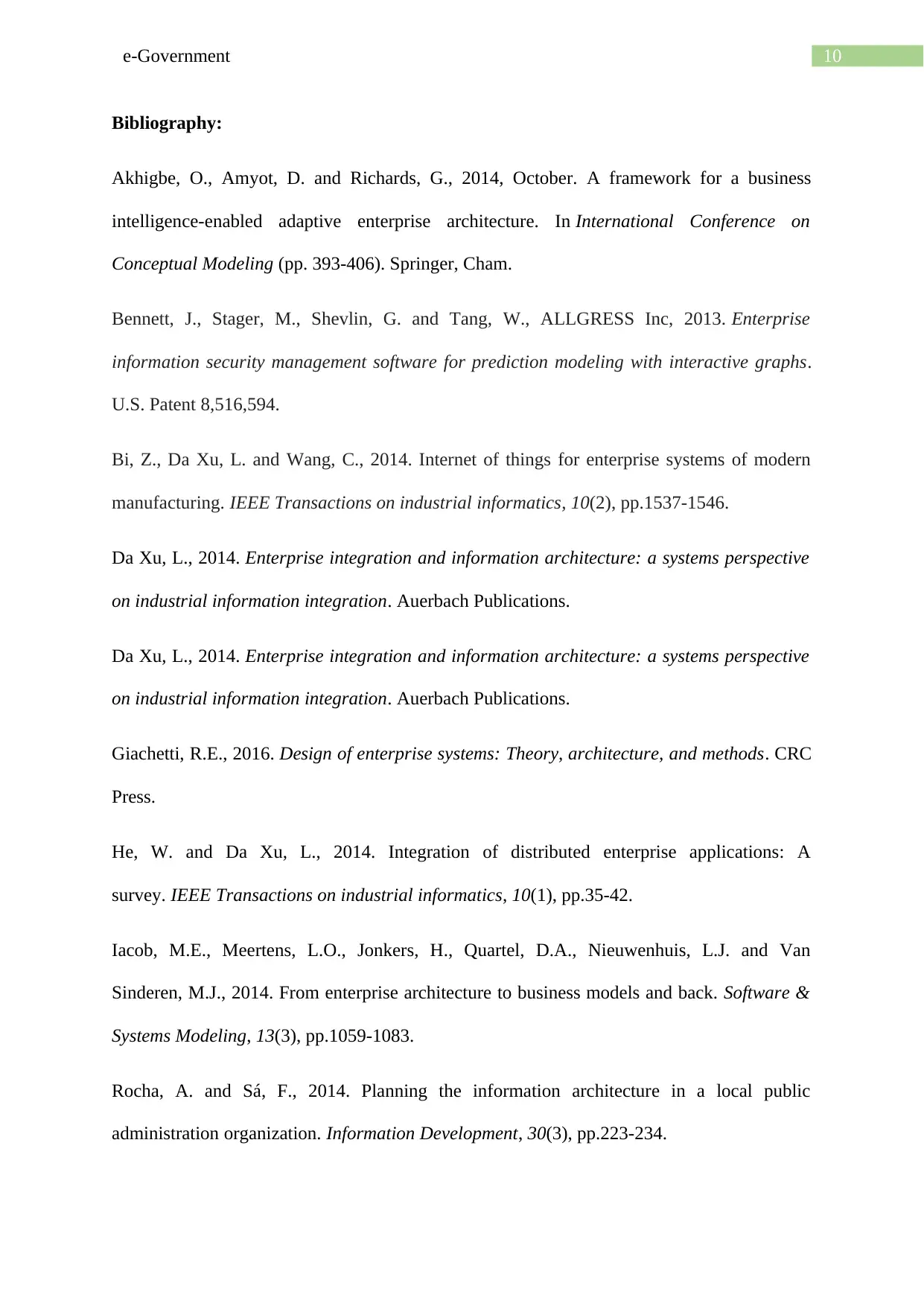
10e-Government
Bibliography:
Akhigbe, O., Amyot, D. and Richards, G., 2014, October. A framework for a business
intelligence-enabled adaptive enterprise architecture. In International Conference on
Conceptual Modeling (pp. 393-406). Springer, Cham.
Bennett, J., Stager, M., Shevlin, G. and Tang, W., ALLGRESS Inc, 2013. Enterprise
information security management software for prediction modeling with interactive graphs.
U.S. Patent 8,516,594.
Bi, Z., Da Xu, L. and Wang, C., 2014. Internet of things for enterprise systems of modern
manufacturing. IEEE Transactions on industrial informatics, 10(2), pp.1537-1546.
Da Xu, L., 2014. Enterprise integration and information architecture: a systems perspective
on industrial information integration. Auerbach Publications.
Da Xu, L., 2014. Enterprise integration and information architecture: a systems perspective
on industrial information integration. Auerbach Publications.
Giachetti, R.E., 2016. Design of enterprise systems: Theory, architecture, and methods. CRC
Press.
He, W. and Da Xu, L., 2014. Integration of distributed enterprise applications: A
survey. IEEE Transactions on industrial informatics, 10(1), pp.35-42.
Iacob, M.E., Meertens, L.O., Jonkers, H., Quartel, D.A., Nieuwenhuis, L.J. and Van
Sinderen, M.J., 2014. From enterprise architecture to business models and back. Software &
Systems Modeling, 13(3), pp.1059-1083.
Rocha, A. and Sá, F., 2014. Planning the information architecture in a local public
administration organization. Information Development, 30(3), pp.223-234.
Bibliography:
Akhigbe, O., Amyot, D. and Richards, G., 2014, October. A framework for a business
intelligence-enabled adaptive enterprise architecture. In International Conference on
Conceptual Modeling (pp. 393-406). Springer, Cham.
Bennett, J., Stager, M., Shevlin, G. and Tang, W., ALLGRESS Inc, 2013. Enterprise
information security management software for prediction modeling with interactive graphs.
U.S. Patent 8,516,594.
Bi, Z., Da Xu, L. and Wang, C., 2014. Internet of things for enterprise systems of modern
manufacturing. IEEE Transactions on industrial informatics, 10(2), pp.1537-1546.
Da Xu, L., 2014. Enterprise integration and information architecture: a systems perspective
on industrial information integration. Auerbach Publications.
Da Xu, L., 2014. Enterprise integration and information architecture: a systems perspective
on industrial information integration. Auerbach Publications.
Giachetti, R.E., 2016. Design of enterprise systems: Theory, architecture, and methods. CRC
Press.
He, W. and Da Xu, L., 2014. Integration of distributed enterprise applications: A
survey. IEEE Transactions on industrial informatics, 10(1), pp.35-42.
Iacob, M.E., Meertens, L.O., Jonkers, H., Quartel, D.A., Nieuwenhuis, L.J. and Van
Sinderen, M.J., 2014. From enterprise architecture to business models and back. Software &
Systems Modeling, 13(3), pp.1059-1083.
Rocha, A. and Sá, F., 2014. Planning the information architecture in a local public
administration organization. Information Development, 30(3), pp.223-234.
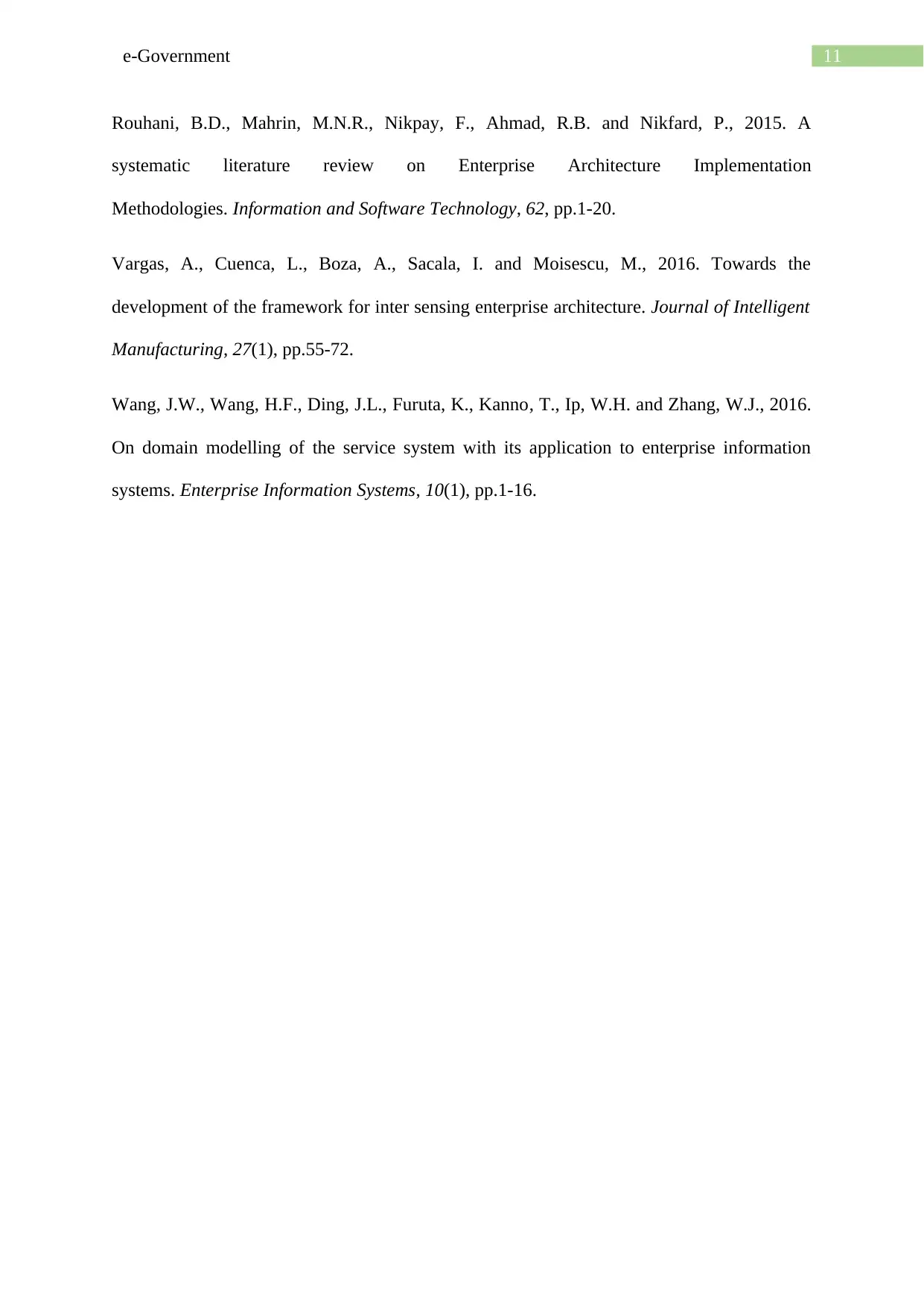
11e-Government
Rouhani, B.D., Mahrin, M.N.R., Nikpay, F., Ahmad, R.B. and Nikfard, P., 2015. A
systematic literature review on Enterprise Architecture Implementation
Methodologies. Information and Software Technology, 62, pp.1-20.
Vargas, A., Cuenca, L., Boza, A., Sacala, I. and Moisescu, M., 2016. Towards the
development of the framework for inter sensing enterprise architecture. Journal of Intelligent
Manufacturing, 27(1), pp.55-72.
Wang, J.W., Wang, H.F., Ding, J.L., Furuta, K., Kanno, T., Ip, W.H. and Zhang, W.J., 2016.
On domain modelling of the service system with its application to enterprise information
systems. Enterprise Information Systems, 10(1), pp.1-16.
Rouhani, B.D., Mahrin, M.N.R., Nikpay, F., Ahmad, R.B. and Nikfard, P., 2015. A
systematic literature review on Enterprise Architecture Implementation
Methodologies. Information and Software Technology, 62, pp.1-20.
Vargas, A., Cuenca, L., Boza, A., Sacala, I. and Moisescu, M., 2016. Towards the
development of the framework for inter sensing enterprise architecture. Journal of Intelligent
Manufacturing, 27(1), pp.55-72.
Wang, J.W., Wang, H.F., Ding, J.L., Furuta, K., Kanno, T., Ip, W.H. and Zhang, W.J., 2016.
On domain modelling of the service system with its application to enterprise information
systems. Enterprise Information Systems, 10(1), pp.1-16.
⊘ This is a preview!⊘
Do you want full access?
Subscribe today to unlock all pages.

Trusted by 1+ million students worldwide
1 out of 12
Related Documents
Your All-in-One AI-Powered Toolkit for Academic Success.
+13062052269
info@desklib.com
Available 24*7 on WhatsApp / Email
![[object Object]](/_next/static/media/star-bottom.7253800d.svg)
Unlock your academic potential
Copyright © 2020–2025 A2Z Services. All Rights Reserved. Developed and managed by ZUCOL.





